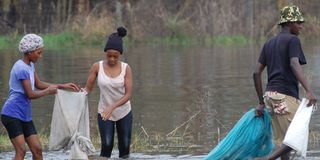Rising Lake Nakuru water levels turn homes into fishing grounds

Residents of Barut living near Lake Nakuru National Park fish in flood waters on July 8 after the lake burst its banks. Experts have warned that lakes Nakuru and Naivasha contain high amounts of toxic heavy metals.
What you need to know:
- Property worth hundreds of thousands of shillings have been destroyed by water.
- And as the displaced land owners ponder their next move, the rising water level is turning out to be a blessing in disguise to some residents.
When a group of urban poor bought a piece of land next to Lake Nakuru National Park, they had one mission: to construct permanent houses.
Nearly 200 members Muungano wa wanavijiji group settled at Barut Ward in Nakuru West and subdivided the land into small plots on which they built permanent houses.
Living a stone’s throw from the popular national park, the group enjoyed a fantastic scenery with a variety of birds and wild animals from the comfort of their homes. Save for the destructive baboons, they have lived there peacefully for many years.

Houses submerged by the rising water levels from Lake Nakuru in Barut Ward in this picture taken on July 9, 2020. PHOTO | FRANCIS MUREITHI |NATION MEDIA GROUP
However, their honeymoon came crumbling last month when Lake Nakuru water levels rose and submerged their homes. They were forced to relocate to higher grounds.
Property worth hundreds of thousands of shillings have been destroyed as several homes remain submerged in water.
And as the displaced land owners ponder their next move, the rising water level is turning out to be a blessing in disguise to some of the residents who have resorted to fishing.
“The fish business is good here,” says a woman as she serves a meal of fish and ugali to a boda boda rider.
She added: “On a good day, I can make up to Sh1,000, “I just hope the water levels will not subside soon because fish harvesting is booming and my customers are increasing by the day.”
There are fears among residents that tilapia fish species in Lake Nakuru are not good for human consumption. However, experts from Nakuru County conducted a study to establish the water quality and the presence of heavy metals in the fish from the lake. Before, only cichlid tilapia could survive in the lake.

A woman fries fish in Barut, Nakuru West, on July 9, 2020. PHOTO | FRANCIS MUREITHI | NATION MEDIA GROUP
With the rising water levels, the lake has turned into a breeding ground for four different species of tilapia like oreochromis niloticus (94.1 per cent), oreochromis variabilis (4.8 per cent), tilapia graham and oreochromis leucosticus whose presence in the lake stands at 0.5 per cent.
“Analysis for selected heavy metals of the two dominant fish species established that heavy metal concentrations in the two fish species were within the recommended Food Agriculture Organization and the World Health Organization limit for fish and fish products except total chromium,” said the joint report.
“The detection of heavy metals in the fish even in small concentration may not have immediate health threats on consumers of fish and fish products from Lake Nakuru, but will likely have adverse effects if there is prolonged consumption of the fish species since heavy metals bio-accumulate,” the report added.
The report that was published last month was prepared by experts from the department of Water, Environment, Energy and Natural Resources, Kenya wildlife Services, Flamingo Net and Kenya Marine, Fisheries and Research Institute.

Residents of Barut display some of the fish from Lake Nakuru on July 9, 2020. PHOTO | FRANCIS MUREITHI | NATION MEDIA GROUP
But even before the report was made public, young men and women from Naivasha had already flooded the area with their wooden boats for fishing expeditions.
“On a good day I could trap more than 200 fish which I sell at between Sh50 and Sh200 depending on their sizes,” said Mr James Kamau.
But some of the affected residents who lack clean water and food have not received any humanitarian aid for two months now. The residents fear there could be an outbreak of malaria and waterborne diseases like dysentery and cholera if no action is taken soon.
Ms Jecinta Mwilu from Akiba Mashinani Trust which gave the land owners loans to construct their houses said that the water levels started rising in March and has so far displaced 117 people.
“There is no stopping the rising water levels and experts predict it could stretch to five kilometers into residential areas and we appeal to the county government to assist the displaced families,” said Ms Mwilu.
A resident Mr Stanley Muchangi said that the water has destroyed their crops.





